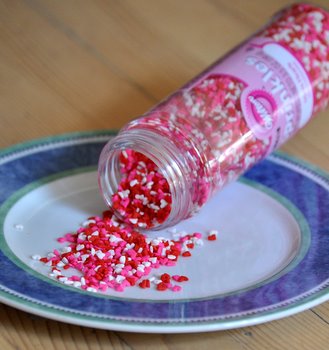
Food coloring can be added to food for a variety of reasons and is used to enhance the natural color of a dish as well as to introduce decorative color to one. The latter is particularly true in baking, where you might want to tint a frosting for a birthday cake or get a truly red shade on your red velvet cake. Everyone is going to have their own preference on whether they like to use food coloring in their home baking or not. For most of us – including myself, as I like a bit of bright color now and again! – food safe dyes are only very occasionally used to begin with and putting a few drops in a batch of Rainbow Cupcakes isn’t a big cause for concern. For those who prefer to use all natural ingredients whenever possible, there are plenty of options for all natural food colorings out there that mean that you don’t have to miss out on those cupcakes, either!
All natural food colorings are generally made with dyes extracted from primarily plant sources, using an extract from turmeric or saffron for a yellow color, for instance. Some of these are also used in standard food colorings, which do use both synthetic and natural colors. They can be difficult to find at conventional markets, but they are often stocked at stores such as Whole Foods and Sur La Table, as well as other specialty food or baking stores. These natural dyes are often more expensive than regular dyes, but like the regular coloring, they will keep for quite some time. India Tree is one brand that produces very good, all natural dyes made from plant sources and it is available several places online as well as in the stores mentioned above. They also make sanding sugars and other decorative products. Other companies (I’ve really only used India Tree, myself) include Nature’s Flavor and Chefmaster.
Feel free to leave notes about your favorite brands in the comments if they haven’t been mentioned here!






Belinda @zomppa
January 25, 2011Oh, thank you for the recommendation!! Great to know red velvets can be safer!
Katherine at Miele Ovens
January 25, 2011India Tree natural food coloring works wonders as we’ve been utilizing this for a while with all of the baking we’ve been doing in our ovens for the holidays. The color that comes from India Tree is top notch and much healthier than the typical food coloring that many are so use to. I personally haven’t used them for red velvet cake or cupcakes yet but I’m positive that they’d be absolutely wonderful.
Anyway, we get ours from Whole Foods as you have mentioned. Also, I have used Chefmaster food colorings as right before Christmas there was a shortage of India Tree both in the cabinets here as well as at our nearest Whole Foods. This was a big issue for the my family due to the fact that I had a nice flour-less cake in the works and it was almost time to pop it in the speed oven when I noticed we were out. Luckily though the Chefmaster worked out just fine!
Thanks for enlightening people with this tip Nicole as I don’t think many people consider the natural ingredients when it comes down to the nitty gritty such as food colorings.
Kruzon
January 25, 2011I like the natural vegetable colorant idea. How many people are daily hopped up on colorant chemicals? Red die 3 used send my kids running in circles and bouncing off the walls.
Carolyn Jung
January 26, 2011I agree with the comment about Red Velvet cakes. I love them, but have often wondered just what unnecessary dyes I’ve been ingesting. Nice to know there is an alternative made from real veggies.
ananda
July 5, 2011You can buy the India Tree Food Colourings online at http://www.anandafoods.co.uk along with their natural cake decorations. Enjoy!
Rebecca
February 10, 2012I’ve tried using the India Tree colors before, but the colors always faded or changed after a while. For example, I used it to color a pink icing for some cookies, and once the icing was dry, it turned purple. Has this happened to anyone else or did I get a bad batch??
SJW
March 28, 2012The reason your food coloring turned purple instead of the blue is probably because over time, the pH (which needed to be basic to make the blue because their blue dye is cabbage based) neutralized. To make it more blue again, add a smudge of baking soda. Put a blob on a paper plate, and mix in a little bit of baking soda and stir. Note that baking soda is taste-able so that sort of sucks and be aware of that if the food you’re making is very delicate in flavor, but if you happen to have green tea, that is also basic (as opposed to acidic) and is less noticeable and you can add that instead of baking soda.
Or if you have spare time, boil down a ton of red cabbage, keep boiling and boiling, then you have purple solution. Fridge it. When you need pink, add acid to it (lemon juice, white wine, or vinegar for example) and when you need blues, add bases to it.
It also keeps well frozen. So, you can make a large batch of it, let it cool, then separate it into zip lock bags and shove into freezer for later usage.
David
June 3, 2012The yellow contains polysorbate and propylene glycol. These are not natural ingredients by any stretch. Best to avoid altogether. In fact, best to make your own – here’s a link I just found that I want to try (can’t guarantee the results – just the first link that came up): http://www.ehow.com/how_2302808_make-natural-food-coloring.html
chemfreemom
June 6, 2012I was just going to say what David said, that India Tree uses polysorbate and propylene glycol in their yellow, and still has the audacity to call them natural. I wouldn’t touch them with a 10-foot pole. I make my own….
Raquel
February 9, 2013I was looking for all natural food dye as I am highly allergic to the synthetic colors that are all over the place and it sort of sucks not only having to watch out for the food I eat when I go out and buy something but doing the same at home. If they use polysorbate and propylene glycol however that stuff wont help me either. Well off recipe hunting for making my own dye now.
Teresa
May 20, 2013How did you find out that it contained Polysorbate and propylene glycol?? Did you buy the product? I tried looking on their site and they don’t list it on the ingredients list! Shame on them if it does contain those!
Teresa
May 21, 2013Inquired with India Tree and here was their response:
Our products do not contain polysorbate or propylene glycol.
Thank you,
Julia Kelley
India Tree
Parker
June 18, 2013Can anyone tell us if these colorings are free from GMO’s??